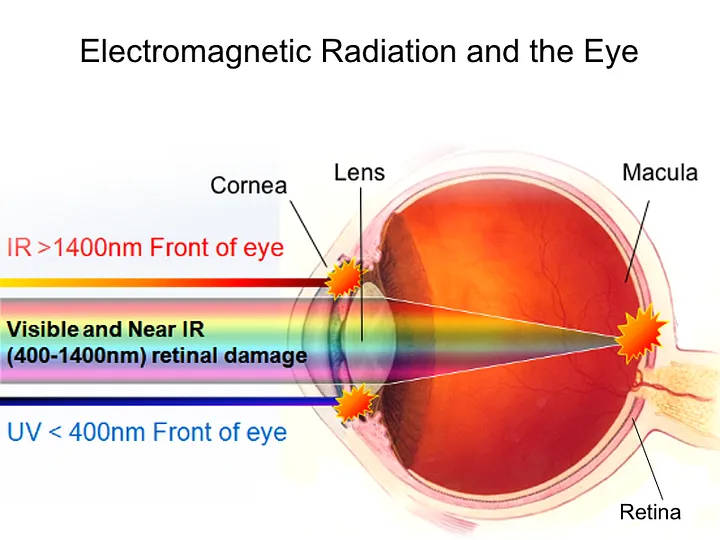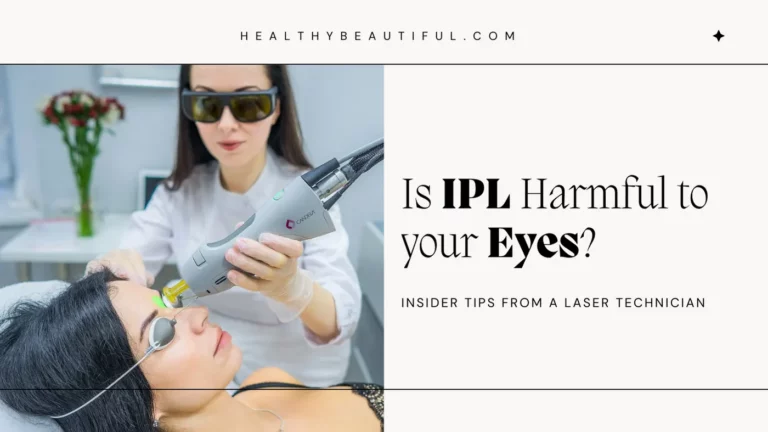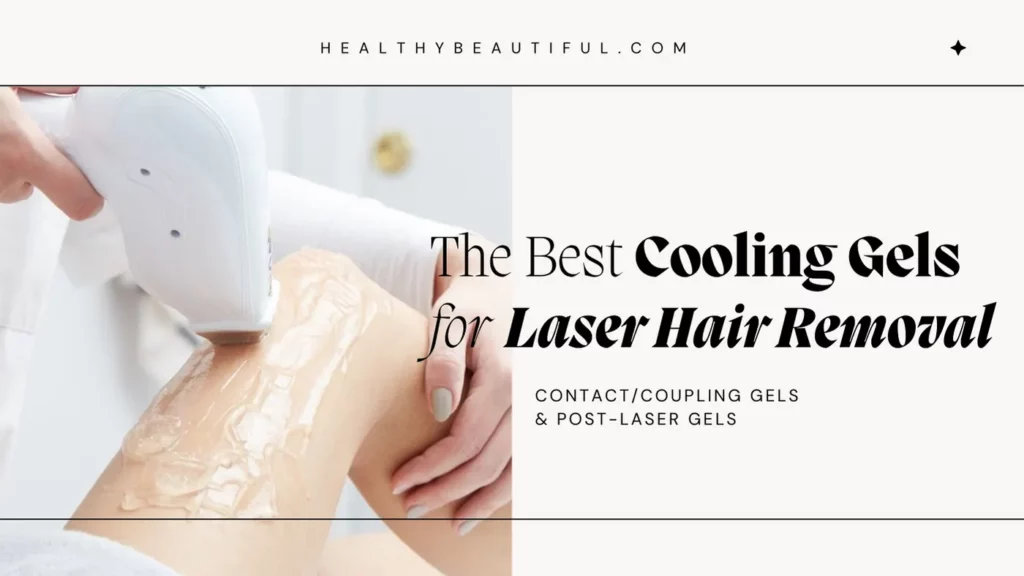Protect Your Eyes from IPL Damage: Insider Tips from a Laser Technician
Considering the potential risks, eye safety is crucial during Intense Pulsed Light (IPL) treatments.
IPL technology used for hair removal, skin rejuvenation, and skin conditions can be harmful primarily to your skin and eyes.
During IPL sessions, professionals and patients must follow safety standards to minimize risk and prevent skin-related or eye-related injuries.
If you plan on doing at-home laser hair removal, you should also understand these risks so you can take necessary precautions to ensure your safety.
In this article, we'll explore the risks linked to IPL therapy based on recent cases and expert insights.
We’ll also discuss essential safety precautions you need to know to protect your eyes during your IPL procedures.
Ask the Expert: Is IPL Harmful to the Eyes?
BY ANGELICA ROSSINO, MEDICAL AESTHETICIAN & LASER TECHNICIAN
Without proper protection, yes.
IPL machines and devices emit intense light pulses that pose risks of potential damage to ocular structures when exposed to the eyes without proper precautions.
Insufficient eye protection during IPL treatments can result in adverse effects on ocular tissues, posing risks of discomfort, irritation, and potential damage to the delicate structures within the eye.
Thankfully, keeping your eyes safe during IPL procedures is relatively easy, as you can follow some basic guidelines.
These practices will help you take the necessary precautions whether you’re getting the procedure at a clinic or doing at-home IPL hair removal.
Video: Laser safety and Eye protection before treatment
For Patients Undergoing Professional Laser Hair Removal:
- Eye Shielding – Clinics must provide specialized patient goggles or eye shields to completely cover and protect your eyes from the laser light during the treatment.
- Qualified Practitioners – Ensuring the treatment is administered by certified professionals with expertise in laser procedures to minimize risks and ensure patient safety.
- Communication – Inform the practitioner immediately if you experience discomfort or unexpected sensations during the treatment.
For At-Home Laser Hair Removal:
- Use of IPL Goggles – Always wear the recommended protective eyewear to shield your eyes from accidental exposure to laser light. Wavelength is very important. The protective effect only exists if goggles are suitable for the wavelength of the IPL/laser you're using. Most IPL devices have a wavelength anywhere between 475-1200nm, so make sure to get safety glasses that cover this range.
- Adhere to Device Limitations – We've reviewed over 35 laser hair removal devices over the years, and no at-home IPL device is currently FDA-cleared for use above the cheekbones and between the eyebrows. The only exception is ViQure EpiPro, which uses a diode laser instead of IPL. Always be cautious when using the device around the facial area or near the eyes, ensuring the laser is directed away from the eyes and surrounding sensitive areas.
- Careful Application – Please do not look directly at an active flash window. It’s also important to never point the treatment window into an open space to emit a light pulse. Always ensure the treatment surface is in full contact with the skin during use. High-end devices often come with a skin contact safety mechanism, which is not always included in more affordable devices.
- Eye Closure or Covering – Close your eyes while using the device in adjacent areas to prevent stray laser light from reaching your eyes.
Adhering to these specific eye safety measures at professional clinics and during at-home laser hair removal sessions significantly reduces the risk of eye damage from laser exposure.
Related: A Comprehensive Study on the Safety & Efficacy of At-Home IPL Hair Removal Devices, Is At-Home Laser Hair Removal Safe? The Complete Safety Checklist for IPL Devices
- Protect Your Eyes from IPL Damage: Insider Tips from a Laser Technician
- Ask the Expert: Is IPL Harmful to the Eyes?
- Expert Tips: IPL Safety & Aftercare
- Understanding Ocular Hazards from IPL Devices
- Ocular Structures and Potential Damage
- Real-Life Cases and Recorded Instances
- Safety Measures and Recommendations
- Recognizing IPL Eye Damage Symptoms
- Conclusion
- References:
Expert Tips: IPL Safety & Aftercare
Learn key information about IPL/ laser safety and aftercare to make the most of your treatments.
Our guides provide clear insights, ensuring you understand how to maintain skin health before, during, and after IPL procedures.
As medical professionals, your well-being is our priority – empower yourself with knowledge for a safe and effective laser hair removal.
The Best Laser Safety Glasses for IPL Hair Removal
The Best Cooling Gels for Laser Hair Removal
+ Get the Best Prices Online
Note: The protective effect only exists if goggles are suitable for the wavelength of the IPL/laser! Most IPL devices have a wavelength anywhere between 475-1200nm, so make sure to get safety glasses that cover this range.
Understanding Ocular Hazards from IPL Devices
While Intense Pulsed Light (IPL) treatments are effective for various skin conditions, the intense light emitted during these procedures poses a potential risk and may cause damage to the eyes if proper eye protection measures are not followed.
It's important to understand the implications of these effects, as they highlight how IPL affects the various structures of the eye.

Photochemical Effects
IPL emits light in various wavelengths, affecting the eye's tissues and potentially leading to photochemical reactions. This can induce alterations within ocular structures, contributing to potential damage.
Photochemical effects refer to changes or reactions that occur within the body's tissues or cells when exposed to light energy.
When intense pulses of light are emitted during IPL treatments, there's a risk that the eyes might absorb some of this light energy.
These photochemical effects specifically related to the eyes can include:
- Retinal Damage – The retina, sensitive to light, can potentially suffer damage if exposed to intense light, leading to alterations in retinal pigments or other cellular changes that might impact vision.
- Iris and Pupil Reactions – Light absorption by the iris or pupil can cause changes in their function or structure, leading to irregularities that affect light entering the eye. This could result in conditions like pupillary defects or irregularities in the iris.
- Inflammatory Responses – Light energy absorbed by the eye's tissues can induce inflammation or irritation, causing discomfort, redness, or other symptoms that indicate ocular stress or damage.
- Long-term Effects – Prolonged or repeated exposure to intense light, even if not immediately noticeable, might contribute to cumulative damage over time, potentially impacting ocular health in the long run.
Understanding these photochemical effects concerning IPL and eye safety is crucial in emphasizing the necessity of protective measures such as wearing appropriate eye shields or goggles during IPL sessions.
These precautions aim to prevent direct exposure of the eyes to intense light pulses, reducing the risk of adverse photochemical effects on ocular tissues.
Photomechanical Effects
The force generated by intense pulsed light can create mechanical stress within ocular tissues, leading to structural alterations.
Photomechanical effects in the context of IPL eye safety refer to the mechanical impact or physical changes that occur within the eye's tissues when exposed to intense pulses of light.
These effects can include:
- Mechanical Stress – Intense pulses of light can generate rapid heating within the targeted tissues. This sudden thermal expansion can create mechanical stress, potentially affecting the delicate structures of the eye.
- Pressure Waves – The rapid heating and expansion of tissues can produce pressure waves within the ocular structures. These waves might cause micro-disruptions or mechanical disturbances within the eye, affecting its normal functioning.
- Tissue Disruption – In extreme cases or with inappropriate IPL settings, the mechanical stress caused by intense light pulses could lead to tissue damage or disruption within the eye, impacting its structural integrity.
Understanding photomechanical effects is important in IPL eye safety because it highlights the need for controlled and proper administration of IPL treatments.
Ensuring the correct parameters, such as pulse duration and energy levels, reduces the risk of generating excessive mechanical stress within the ocular tissues, minimizing potential harm to the eyes during IPL procedures.
Photothermal Effects
IPL machines generate heat within the tissues due to light absorption, potentially causing thermal damage to ocular structures. This thermal effect varies based on the wavelengths emitted by IPL and lasers.
Different wavelengths emitted by IPL and lasers have distinct impacts on ocular structures. While some wavelengths may penetrate deeper into tissues, others might affect superficial layers.
The light absorption by various ocular structures and tissues determines the potential hazards associated with specific wavelengths.
These effects can include:
1. Temperature Rise – Intense pulses of light absorbed by ocular tissues can elevate their temperature, leading to localized heating. Excessive heat can potentially damage or affect the function of eye structures.
2. Tissue Damage – Prolonged or intense exposure to IPL light can result in thermal damage to the eye's tissues. This can include damage to the retina, cornea, lens, or other ocular structures.
3. Inflammatory Responses – Heat generated by IPL light absorption might induce inflammatory reactions in the eye, causing discomfort, redness, or swelling in the treated area.
Understanding photothermal effects is crucial in IPL eye safety
as it emphasizes the importance of controlled and monitored light exposure during treatments.
Proper calibration of IPL devices and adherence to recommended safety parameters help prevent excessive heating of ocular tissues, reducing the risk of eye thermal damage.
Additionally, protective measures such as using appropriate eye shields or goggles aim to minimize direct exposure of the eyes to intense light, thereby mitigating potential photothermal effects on ocular health.
Ocular Structures and Potential Damage
Ocular structures such as the retina, cornea, lens, and iris exhibit vulnerability to IPL wavelengths, potentially resulting in diverse forms of damage.
- Retina and Cornea – The retina, responsible for light-to-electrical signal conversion, and the cornea, aiding in light focus, are susceptible to IPL wavelengths. Absorption of specific wavelengths by these structures may induce thermal damage, leading to varying degrees of impairment.
- Lens and Iris – IPL exposure poses risks to the lens, located behind the iris, and the iris itself, which is rich in melanin pigment. The lens, crucial for light focusing, can suffer cataracts and photochemical damage from specific IPL wavelengths. Similarly, the iris, controlling light entry, absorbs light and may experience damage, affecting its function and potentially causing ocular hypertension.
- Risks from Blue Light and Infrared Exposure – Though minimal, blue light emitted by IPL devices can be absorbed by retinal pigments, leading to temperature elevation within the retina and a heightened risk of permanent ocular damage. Additionally, infrared exposure poses threats such as corneal burns and lens-related complications, raising concerns about their impact on ocular health.
Understanding the vulnerability of these ocular structures to IPL wavelengths illuminates the potential risks and diverse forms of damage that may occur.
Addressing the risks associated with blue light and infrared exposure underscores the necessity of safeguarding ocular health during IPL therapy.
Real-Life Cases and Recorded Instances
- Ocular Injuries Post-IPL Treatment – Several documented cases highlight ocular injuries following IPL treatment. Instances of patients experiencing adverse effects, such as anterior uveitis, iris damage, and discomfort post-treatment, underscore the potential risks associated with IPL therapy. These cases serve as cautionary tales, emphasizing the importance of stringent safety protocols during IPL sessions.
- Iris Damage and Professional IPL-Related Ocular Injuries – Recorded instances in the literature showcase scenarios where patients suffered iris damage post-professional IPL treatments. Iris photoablation and anterior uveitis resulting from IPL therapy elucidate the susceptibility of ocular structures, particularly the iris, to potential damage.
- Low Incidence of Documented Professional IPL Ocular Injuries – Despite the widespread use of IPL technology, recorded cases of professional IPL-related ocular injury remain relatively low. Rare instances of documented ocular injury post-professional IPL treatments suggest that while such incidents occur, the incidence rate remains notably low compared to the widespread utilization of IPL devices.
While cases of adverse effects exist, the incidence of documented professional IPL ocular injuries remains comparatively low, emphasizing the importance of caution and adherence to safety measures.
Safety Measures and Recommendations
For In-Clinic IPL:
- Protective Eyewear – Ensure the provision of appropriate protective eyewear during IPL sessions to shield patients' eyes from harmful light emissions.
- Qualified Practitioners – Employ trained and certified professionals well-versed in IPL procedures to administer treatments, minimize the risk of errors, and ensure patient safety.
- Safety Protocols – Implement stringent safety protocols, including proper positioning of ocular shields or goggles and adherence to recommended safety distances during IPL sessions.
- Compliance with Regulatory Standards – Adhere strictly to regulatory guidelines and standards set by health regulatory authorities concerning IPL device usage, maintenance, and safety measures.
- Patient Education – Offer comprehensive education to patients regarding potential risks, safety measures, and post-treatment care to enhance awareness and promote a responsible approach to IPL treatments.
For Home IPL Devices:
- Device Certification – Prioritize purchasing home IPL devices that comply with established safety standards and possess certification from reputable regulatory bodies or organizations.
- Safety Features – Opt for devices equipped with built-in safety features such as skin tone sensors, automatic shut-off mechanisms, and eye safety sensors to mitigate risks during at-home use.
- Clear Instructions – Choose devices that come with clear and concise safety instructions provided by the manufacturer, ensuring users understand and follow recommended safety protocols.
- User Training and Awareness – Educate yourself thoroughly on device usage by following manufacturer-provided guidelines and training materials. Be aware of potential risks, use the device responsibly, and seek professional advice if needed.
- Regular Maintenance – Maintain the IPL device according to manufacturer recommendations, ensuring proper functionality and reducing the risk of malfunction or unexpected adverse effects.
Adhering to these actionable items and safety standards is crucial for ensuring optimal safety and minimizing potential risks associated with both in-clinic and at-home IPL treatments.
Recognizing IPL Eye Damage Symptoms
IPL treatments, when appropriately administered with adequate eye protection, should not cause discomfort or hurt the eyes. However, without appropriate safety measures, there is a risk of potential eye damage due to the intense light emitted.
Recognizing the symptoms that could indicate eye injury or discomfort following an IPL procedure is crucial.
Common IPL-induced eye damage symptoms include:
- Eye Pain – Immediate or persistent pain in the eyes following an IPL session could signify ocular discomfort or injury.
- Photophobia – Increased sensitivity to light, particularly in brightly lit environments, might persist after the treatment.
- Vision Disturbances – Any sudden changes in vision, such as blurriness or disturbances, should be monitored and reported.
- Redness or Irritation – Noticeable redness, swelling, or irritation in or around the eyes after an IPL treatment might indicate potential eye strain.
- Pupillary Irregularities – Irregular changes in the pupils' size, shape, or responsiveness might indicate underlying ocular issues post-IPL.
It's essential to promptly seek medical attention if these symptoms persist or worsen after an IPL treatment.
Recognizing and addressing these symptoms early can aid in preventing further complications and ensuring appropriate eye care.
Conclusion
The conversation surrounding the use of IPL treatments and their impact on eye health highlights some crucial points. The dangers associated with IPL therapy, caused by photochemical, photomechanical, and photothermal effects, emphasize the need to prioritize ocular safety during these procedures.
Understanding the vulnerability of ocular structures, such as the retina, cornea, lens, and iris, to IPL wavelengths highlights the potential absorption and damage of light. This underlines the importance of implementing strict safety measures. Risks linked to blue light and infrared exposure further emphasize the various forms of potential damage that can affect different parts of the eye.
Real-life examples of post-IPL treatment cases serve as a warning, highlighting the need to adhere to safety protocols and use protective eyewear. While instances of professional IPL-related ocular injury remain relatively low, it is crucial to prioritize cautionary measures and strictly follow safety guidelines to maintain ocular health.
To conclude, when considering IPL procedures, a cautious approach is essential. Prioritizing eye safety through stringent adherence to safety protocols, using protective eyewear, and providing comprehensive patient education is vital to ensure safe and effective IPL treatments. Recognizing and mitigating potential risks is imperative to safeguard ocular health during IPL therapy.
References:
- Town, G., & Ash, C. (2010). Are home-use intense pulsed light (IPL) devices safe?. Lasers in medical science, 25, 773-780.
- Fodor, L., & Sita-Alb, L. (2020). IPL Safety: Legal Issues. Aesthetic Applications of Intense Pulsed Light, 25-32.
- Clarkson, D. M. (2006). Determination of eye safety filter protection factors associated with retinal thermal hazard and blue light photochemical hazard for intense pulsed light sources. Physics in Medicine & Biology, 51(4), N59.
- Bäumler, W. (2010). Safety/eye protection. In Laser and IPL Technology in Dermatology and Aesthetic Medicine (pp. 383-393). Berlin, Heidelberg: Springer Berlin Heidelberg.
- Slatkine, M., & Elman, M. (2003). Conversion of aesthetic lasers and intense pulsed light sources into inherently eye‐safe units. Journal of Cosmetic and Laser Therapy, 5(3-4), 175-181.
- Eadie, E., Miller, P., Goodman, T., & Moseley, H. (2009). Assessment of the optical radiation hazard from a home‐use intense pulsed light (IPL) source. Lasers in Surgery and Medicine: The Official Journal of the American Society for Laser Medicine and Surgery, 41(7), 534-539.
- Sliney, D. H. (2009). Eye safety of laser and light-based devices. In Cosmetics Applications of Laser & Light-Based Systems (pp. 499-516). William Andrew Publishing.
- Javey, G., Schwartz, S. G., & Albini, T. A. (2010). Ocular complication of intense pulsed light therapy: iris photoablation. Dermatologic surgery, 36(9), 1466-1468.
- Lee, W. W., Murdock, J., Albini, T. A., O'brien, T. P., & Levine, M. L. (2011). Ocular damage secondary to intense pulse light therapy to the face. Ophthalmic Plastic & Reconstructive Surgery, 27(4), 263-265.









